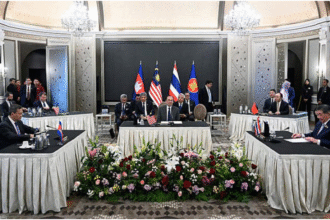By Lamin Guèye
Shanghai, China – As tensions escalate between China and the United States, Beijing is accelerating efforts to promote the global use of its currency, the yuan, by expanding its cross-border payment system across Africa, Central Asia, and the Middle East.
On Wednesday, six financial institutions officially joined the Cross-border Interbank Payment System (CIPS) as direct participants, marking a significant step in China’s ambition to offer an alternative to the widely used Society for Worldwide Interbank Financial Telecommunication (SWIFT) system.
The new entrants include the African Export-Import Bank, First Abu Dhabi Bank, South Africa’s Standard Bank, Singapore’s United Overseas Bank, the Kyrgyzstan-based Eldik Bank, and Chongwa (Macau) Financial Asset Exchange. These additions bring the total number of direct participants in CIPS to 174 as of the end of May.
Launched in 2015, CIPS allows participating financial institutions to clear and settle yuan-denominated transactions directly, bypassing the SWIFT system. While the majority of direct participants are currently domestic and overseas branches of Chinese banks, the recent additions signal a widening international adoption of the payment system.
In 2023, transactions made via CIPS reached 175 trillion yuan (US$24.4 trillion), representing a 43% year-on-year increase. This growth reflects Beijing’s push to popularize the system amidst rising trade and technology tensions with the US, with Chinese officials voicing concerns about the potential weaponization of financial tools.
Speaking at the Lujiazui Forum on Wednesday, Pan Gongsheng, governor of the People’s Bank of China, stated that “As geopolitical tensions escalate, traditional cross-border payment infrastructure is prone to being politicized and weaponized as a unilateral sanction tool, undermining the international financial order.” While Pan did not explicitly name the US, his remarks were likely a reference to the exclusion of Russian banks from the SWIFT system following the invasion of Ukraine.
Chinese academics have long expressed concerns about the vulnerability of China to US financial sanctions, especially since the trade war initiated by former US President Donald Trump.
Despite a trade truce and agreements to roll back tariffs, tensions between Beijing and Washington remain, with a permanent deal to de-escalate the trade war yet to be finalized.
While the US dollar remains the dominant currency in international payments, reserves, and forex trading, its position is facing increasing scrutiny. In May, 48.5% of transactions conducted via SWIFT used dollars, compared to just 2.9% for the yuan. Furthermore, the yuan accounted for 2.18% of global forex reserves at the end of 2024, while the US dollar made up 57.8%, according to the International Monetary Fund.
Pan advocates for a more efficient, secure, inclusive, and diverse global payment system, highlighting the growing trend of countries shifting towards local currency transactions. “The situation where a single currency dominates cross-border transactions is changing,” he asserted. “After more than a decade of development, China has preliminarily established a yuan cross-border payment network with multiple channels and wide coverage.”
In April, China’s central bank and the Shanghai municipal government unveiled a plan to bolster the city’s cross-border finance sector, which included measures to further expand CIPS’s global reach and explore the integration of blockchain technology into the system. The expansion of CIPS reflects China’s strategic ambition to establish the yuan as a viable alternative in the global financial landscape, particularly in the face of growing geopolitical uncertainties.









